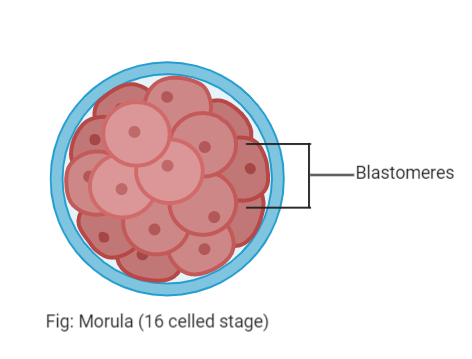Answer
374.7k+ views
Hint: A morula is an early-stage embryo composed of 16 cells in a solid ball located within the Zona Pellucida. A zygote is formed by the fusion of the male gamete and the female gamete during fertilization. It has a high genetic content at this stage.
Complete answer: The zygote undergoes cleavage after fertilization, forming 2-celled embryos first. After which, all of these cells are subjected to mitosis and divisions, taking the cell count to 4. Repeated divisions boost the number of cells that make up the embryo, or blastomeres. The embryo is a dense ball of blastomeres called a morula at about the 32-cell level. Due to rapid cleavage divisions, a morula would have about the same amount of cytoplasm as the zygote, but a greatly increased amount of DNA.

Cleavage refers to the rapid cell divisions that turn a single-celled zygote into a multicellular structure. The daughter cells formed by zygote cleavage are referred to as blastomeres. The first zygote cleavage creates two cells that then split to form four cells, and so on. A morula is known as the 16-celled embryonic stage. The rapid division of cells during zygote cleavage is not followed by an increase in cell mass. This would be due to the short interphase resulting in a decrease in the size of blastomeres as the total cytoplasmic mass remains close to that of a zygote with increasing numbers. Therefore, the morula has about the same cytoplasmic weight as the zygote. Each cleavage division is accompanied by DNA replication with an equal allocation of doubled DNA to daughter cells. Each cell division, thus, doubles the morula's DNA content.
Hence, the correct answer is option D.
Note: The placenta serves as a membrane between the mother and the foetus. The placenta functions as an ultrafilter, whereby soluble nutrients, minerals, hormones, antibodies, will move over it and move into the fetus, even though the blood of the foetus and mother does not combine or blend. Also, it helps to share gases between the two and to remove the fetus from nitrogen waste.
Complete answer: The zygote undergoes cleavage after fertilization, forming 2-celled embryos first. After which, all of these cells are subjected to mitosis and divisions, taking the cell count to 4. Repeated divisions boost the number of cells that make up the embryo, or blastomeres. The embryo is a dense ball of blastomeres called a morula at about the 32-cell level. Due to rapid cleavage divisions, a morula would have about the same amount of cytoplasm as the zygote, but a greatly increased amount of DNA.

Cleavage refers to the rapid cell divisions that turn a single-celled zygote into a multicellular structure. The daughter cells formed by zygote cleavage are referred to as blastomeres. The first zygote cleavage creates two cells that then split to form four cells, and so on. A morula is known as the 16-celled embryonic stage. The rapid division of cells during zygote cleavage is not followed by an increase in cell mass. This would be due to the short interphase resulting in a decrease in the size of blastomeres as the total cytoplasmic mass remains close to that of a zygote with increasing numbers. Therefore, the morula has about the same cytoplasmic weight as the zygote. Each cleavage division is accompanied by DNA replication with an equal allocation of doubled DNA to daughter cells. Each cell division, thus, doubles the morula's DNA content.
Hence, the correct answer is option D.
Note: The placenta serves as a membrane between the mother and the foetus. The placenta functions as an ultrafilter, whereby soluble nutrients, minerals, hormones, antibodies, will move over it and move into the fetus, even though the blood of the foetus and mother does not combine or blend. Also, it helps to share gases between the two and to remove the fetus from nitrogen waste.
Recently Updated Pages
Basicity of sulphurous acid and sulphuric acid are

What is the stopping potential when the metal with class 12 physics JEE_Main

The momentum of a photon is 2 times 10 16gm cmsec Its class 12 physics JEE_Main

Using the following information to help you answer class 12 chemistry CBSE

Which of the following would not be a valid reason class 11 biology CBSE

Why should electric field lines never cross each other class 12 physics CBSE

Trending doubts
Difference Between Plant Cell and Animal Cell

Difference between Prokaryotic cell and Eukaryotic class 11 biology CBSE

Fill the blanks with the suitable prepositions 1 The class 9 english CBSE

Fill the blanks with proper collective nouns 1 A of class 10 english CBSE

Change the following sentences into negative and interrogative class 10 english CBSE

Select the word that is correctly spelled a Twelveth class 10 english CBSE

What organs are located on the left side of your body class 11 biology CBSE

What is the z value for a 90 95 and 99 percent confidence class 11 maths CBSE

Give 10 examples for herbs , shrubs , climbers , creepers



